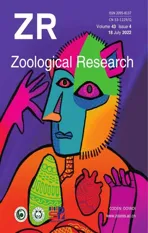Europe vs.China:Pholcus (Araneae,Pholcidae) from Yanshan-Taihang Mountains confirms uneven distribution of spiders in Eurasia
2022-08-05YingLu,ChangChu,Xiao-QingZhang等
DEAR EDITOR,
Morphological and molecular data were used to study 35 species of thePholcus phungiformesspecies group from the Yanshan-Taihang Mountains in China.The uneven distribution pattern of spiders in Eurasia is discussed,with a focus on Europe and China.
Europe covers approximately 10.18 million km2in western Eurasia,while China covers about 9.6 million km2in the east.Due to their relative positions to each other and similar land areas,spider species richness in Europe and China is comparable (Li,2020).Indeed,Europe contains a total of 5 441 species in 727 genera from 63 spider families (Nentwig et al.,2022),and China contains a total of 5 452 species in 827 genera from 69 families (Biodiversity Committee of the Chinese Academy of Sciences,2020),with about 80% of families in common.
Although research on European spiders has a long and comprehensive history,research on Chinese spiders is still in the initial stage.The first checklist of spiders in China reported 521 species in 149 genera from 34 families (Wang &Zhu,1963),while the second checklist included 1 050 species in 46 families (Zhu,1983).Song et al.(1999),who published the first English book on Chinese spiders,reported 2 361 species in 450 genera from 56 families,while Li (2020) reported 5 084 species in 809 genera from 69 spider families.Thus,we predict that the number of spider species in China will increase significantly in the coming years,and that the number of spider species in China is much higher than that in Europe(Li et al.,2021;Yao et al.,2021).Our above hypothesis is based on the uneven distribution patterns of spiders in Eurasia.Due to the Great European Plain,Europe has the lowest average elevation of any continent overall.During the Pleistocene,80% of glacial ice lay in the Northern Hemisphere,covering most of northern Europe,leading to mass species extinctions (Cox et al.,2019).In contrast,China’s mountainous landscape provided refuge for organisms,enabling species such as spiders to survive glacial periods,but acting as a barrier to species dispersal after glaciation(Figure 1).

Figure 1 Simplified graphical comparison of spiders in western and eastern Eurasia during glaciation and the Holocene
Our current study on thePholcus phungiformesspecies group from the Yanshan-Taihang Mountains in China provides further evidence that spiders are potentially more species rich in China than in Europe.PholcusWalckenaer,1805 of the family Pholcidae C.L.Koch,1850 contains 362 species,most of which are from the Northern Hemisphere,including 15 from Europe (Nentwig et al.,2022) and 134 from China (Li,2020).Moreover,in a single 16-day expedition in the Yanshan-Taihang Mountains,we discovered 13 species new to science.Thus,a large amount of spider diversity in China is yet to be discovered,consistent with recent studies on other spider taxa in China (Li et al.,2021;Liu et al.,2022;Yao et al.,2021).For detailed morphological descriptions,diagnoses,and illustrations of the new species,please see the Supplementary Materials.
NOMENCLATURAL ACTS REGISTRATION
The specimens studied were deposited in the College of Life Science,Shenyang Normal University (SYNU) in Liaoning,China,Institute of Zoology,Chinese Academy of Sciences(IZCAS) in Beijing,China,and Museum of Hebei University(MHBU) in Hebei,China.The electronic version of this article in portable document format represents a published work according to the International Commission on Zoological Nomenclature (ICZN),and hence the new names contained in the electronic version are effectively published under the Code from the electronic edition alone (see Articles 8.5–8.6 of the Code).This published work and the nomenclatural acts it contains have been registered in ZooBank,the online registration system for the ICZN.The ZooBank LSIDs (Life Science Identifiers) can be resolved and the associated information can be viewed through any standard web browser by appending the LSID to the prefix http://zoobank.org/.Publication
LSID:urn:lsid:zoobank.org:pub:102CC3B4-2E9B-420CA83F-9491662B690E
PholcuschangchiYao,Li &Lu,sp.nov.
LSID:urn:lsid:zoobank.org:act:0A26DCC5-FD77-4202-A1E4-093D62720A41
Pholcus chengdeYao,Li &Lu,sp.nov.
LSID:urn:lsid:zoobank.org:act:7393BD56-52EB-4086-B376-47C264574BEF
Pholcus datongYao,Li &Lu,sp.nov.
LSID:urn:lsid:zoobank.org:act:EA15CDDA-E772-46F4-AE86-22534512DE1F
PholcusfengningYao,Li &Lu,sp.nov.
LSID:urn:lsid:zoobank.org:act:2D1B10F4-7584-4222-ABBABC87091D0CF7
PholcusguanglingYao,Li &Lu,sp.nov.
LSID:urn:lsid:zoobank.org:act:1663418B-05F5-4A3E-8D9D-1DD6167A5D09
Pholcus huailaiYao,Li &Lu,sp.nov.
LSID:urn:lsid:zoobank.org:act:6AD43FA6-A3E9-4AA3-A9D2-39BA8647D222
PholcushunyuanYao,Li &Lu,sp.nov.
LSID:urn:lsid:zoobank.org:act:455C57CE-A681-4F46-9B67-FB6629AE5105
PholcuskuaileYao,Li &Lu,sp.nov.
LSID:urn:lsid:zoobank.org:act:1D51DCCD-3C05-48BABDDD-882BCDA02583
PholcusluanpingYao,Li &Lu,sp.nov.
LSID:urn:lsid:zoobank.org:act:1EC5BD9B-35F4-4B12-AF75-3CFF54109DD0
Pholcus tangYao,Li &Lu,sp.nov.
LSID:urn:lsid:zoobank.org:act:A6A8D338-F9B2-444E-9889-B8B62EB13F3A
PholcusxinglongYao,Li &Lu,sp.nov.
LSID:urn:lsid:zoobank.org:act:7520BF42-F9A9-460F-B637-6A03533BDEBC
PholcusxinzhouYao,Li &Lu,sp.nov.
LSID:urn:lsid:zoobank.org:act:F216430D-81FA-465D-9BCAA0830C0BA895
PholcusyanqingYao,Li &Lu,sp.nov.
LSID:urn:lsid:zoobank.org:act:87FD0446-CAB8-4907-AF4DB31B0342152C
SCIENTIFIC FIELD SURVEY PERMISSION INFORMATION
Permission for field surveys in Hebei was granted by the Hebei Provincial Department of Forestry,Shijiazhuang,China.
SUPPLEMENTARY DATA
Supplementary data to this article can be found online.
COMPETING INTERESTS
The authors declare that they have no competing interests.
AUTHORS’ CONTRIBUTIONS
Z.Y.Y.and S.Q.L.designed the study.Z.Y.Y.and Y.L.contributed to fieldwork.Z.Y.Y.performed morphological species identification and collected and analyzed molecular data.Y.L.and C.C.finished the species descriptions and took the photos.X.Q.Z.illustrated the figures in the main text.Z.Y.Y.,S.Q.L.,and Y.L.drafted and revised the manuscript.All authors read and approved the final version of the manuscript.
ACKNOWLEDGMENTS
We are grateful to Fang-Yu Zhao for contributing to the fieldwork,Feng Zhang for loans of type specimens,and Qiao-Qiao He for valuable suggestions on the original draft.We thank Sarah Crews for checking the English and Robert A.Spicer and Yuri M.Marusik for providing critical comments on an early version.
Ying Lu1,Chang Chu1,Xiao-Qing Zhang2,Shu-Qiang Li2,*,Zhi-Yuan Yao1,3,4,*
1College of Life Science,Shenyang Normal University,Shenyang,Liaoning110034,China
2Institute of Zoology,Chinese Academy of Sciences,Beijing100101,China
3Liaoning Key Laboratory of Evolution and Biodiversity,Shenyang,Liaoning110034,China
4Liaoning Key Laboratory for Biological Evolution and Agricultural Ecology,Shenyang,Liaoning110034,China
*Corresponding authors,E-mail:lisq@ioz.ac.cn;yaozy@synu.edu.cn
杂志排行
Zoological Research的其它文章
- Zoological Research call for papers of Cavefish Special Issue
- Fuel source shift or cost reduction:Context-dependent adaptation strategies in closely related Neodon fuscus and Lasiopodomys brandtii against hypoxia
- Ecological study of cave nectar bats reveals low risk of direct transmission of bat viruses to humans
- Population and conservation status of a transboundary group of black snub-nosed monkeys (Rhinopithecus strykeri) between China and Myanmar
- Nucleus accumbens-linked executive control networks mediating reversal learning in tree shrew brain
- Author Correction:A new species of the gudgeon genus Microphysogobio Mori,1934 (Cypriniformes:Cyprinidae) from Zhejiang Province,China
